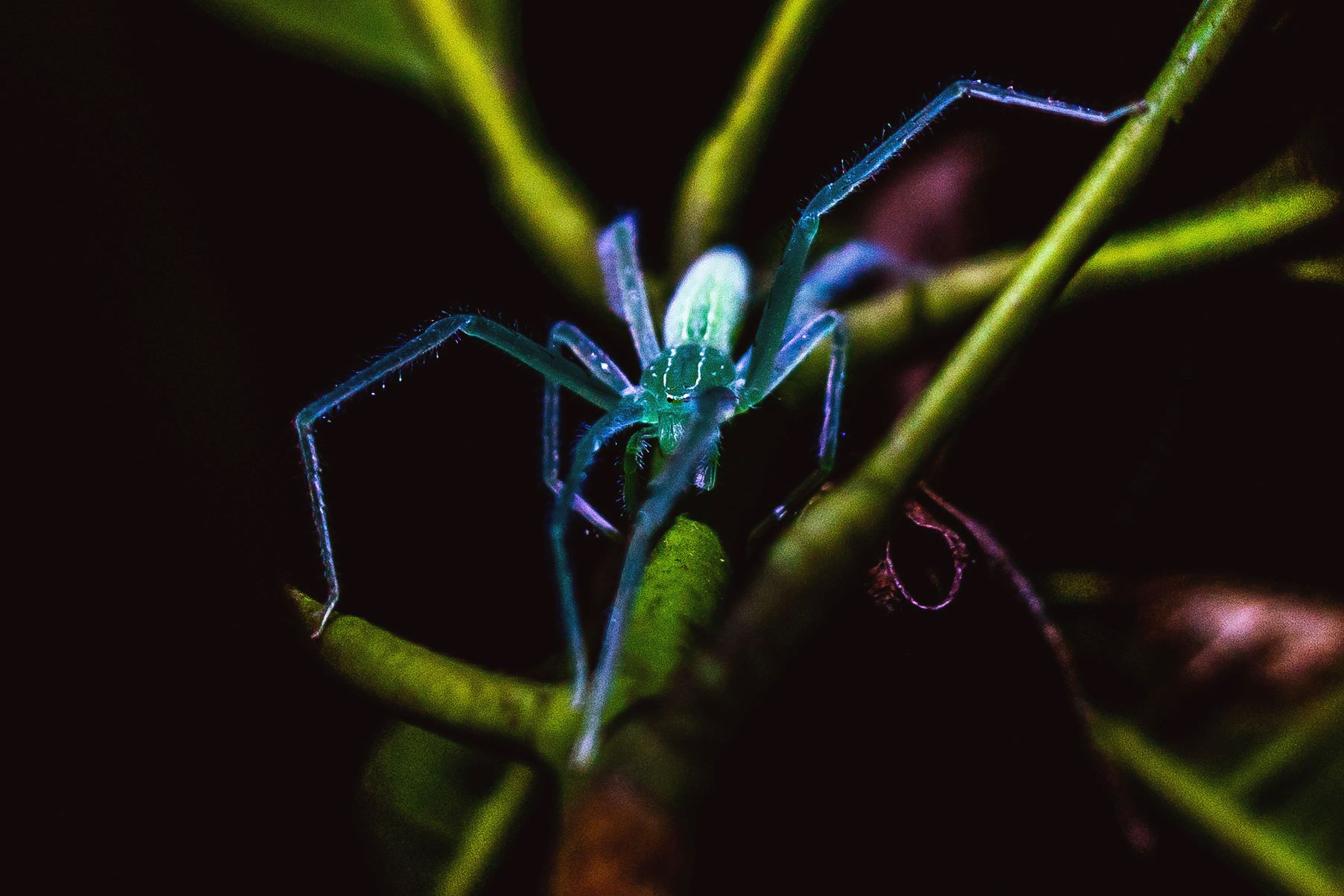
Spiders, with their eight legs and multiple eyes, have always been a fascinating and often feared creature. Among the vast array of spider species, the Blue Huntsman Spider stands out with its striking appearance and intriguing behavior. Found in various parts of the world, these arachnids are known for their beautiful blue hue and impressive hunting skills.
In this article, we will delve into the captivating world of the Blue Huntsman Spider and uncover 17 astonishing facts that will leave you awestruck. From their unique habitat preferences to their incredible ability to camouflage, these spiders have evolved numerous survival tactics that make them truly remarkable.
So, if you’re ready to embark on an adventure into the world of Blue Huntsman Spiders, buckle up and read on!
Key Takeaways:
- The Blue Huntsman Spider is a fascinating arachnid with vibrant blue coloration, large size, and unique behaviors. Despite their venomous fangs, they are beneficial predators and play a vital role in their ecosystem.
- With incredible vision and skilled hunting abilities, Blue Huntsman Spiders are primarily nocturnal and non-aggressive towards humans. Their blue coloration serves as camouflage, and they contribute to controlling insect populations in their habitats.
The Blue Huntsman Spider belongs to the Sparassidae family.
The Blue Huntsman Spider, scientifically known as Heteropoda genus, is a fascinating arachnid that falls under the Sparassidae family. With its vibrant blue coloration, it’s known for its striking appearance.
They are primarily found in Southeast Asia.
The Blue Huntsman Spider is predominantly found in the tropical and subtropical regions of Southeast Asia, including countries such as Thailand, Malaysia, and Indonesia.
These spiders are known for their large size.
The Blue Huntsman Spider can grow to impressive sizes, with a leg span of up to 20 centimeters. This makes them one of the largest spider species in their range.
They have venomous fangs.
Like other huntsman spiders, the Blue Huntsman Spider possesses venomous fangs. However, their venom is relatively weak and not of significant medical concern to humans.
They are excellent hunters.
The Blue Huntsman Spider is an agile and skilled hunter. They use their quick movements and strong legs to chase down and capture their prey.
They have unique mating behaviors.
During the mating process, the male Blue Huntsman Spider performs an elaborate courtship dance to impress the female. This involves intricate leg movements and vibrations on the substrate.
Blue Huntsman Spiders are known for their parental care.
Unlike many other spider species, the female Blue Huntsman Spider lays her eggs in a sac and carries it with her wherever she goes. She fiercely protects and defends her offspring until they hatch.
They are predominantly nocturnal.
The Blue Huntsman Spider is a predominantly nocturnal creature, preferring to hunt and explore during the nighttime hours. During the day, they typically find shelter in crevices or under bark.
They possess incredible vision.
With their eight eyes, positioned on top of their head, Blue Huntsman Spiders possess excellent vision. This allows them to detect movement and track their prey with precision.
They are not aggressive towards humans.
Despite their intimidating appearance, Blue Huntsman Spiders are generally shy and non-aggressive towards humans. They prefer to avoid confrontation and will only bite if provoked or threatened.
Their blue coloration serves as a form of camouflage.
The vibrant blue coloration of the Blue Huntsman Spider helps them blend into their natural surroundings, such as foliage or flowers. This acts as a form of camouflage, making it harder for predators to spot them.
They molt several times throughout their lifespan.
Blue Huntsman Spiders undergo multiple molting stages as they grow. During this process, they shed their old exoskeleton and form a new, larger one to accommodate their increasing size.
They have been observed displaying social behaviors.
In certain circumstances, Blue Huntsman Spiders have been observed living in communal nests. This is a unique behavior among spiders and indicates a level of social interaction.
The Blue Huntsman Spider is a beneficial predator.
These spiders play an essential role in controlling insect populations in their habitats. By feeding on various insects, they contribute to the natural balance of the ecosystem.
They are skilled climbers.
The Blue Huntsman Spider possesses strong, elongated legs that enable them to climb various surfaces with ease. This allows them to explore their surroundings and search for prey from different vantage points.
Their lifespan can range from 1 to 2 years.
On average, the Blue Huntsman Spider lives for about 1 to 2 years. However, their lifespan can vary depending on various factors, including environmental conditions and availability of resources.
They are an integral part of their ecosystem.
The Blue Huntsman Spider plays a vital role in maintaining the balance of their ecosystem. By controlling the population of insects, they contribute to the overall health and stability of the habitat.
Conclusion
The Blue Huntsman Spider is a fascinating creature that captivates both spider enthusiasts and general nature lovers alike. With its striking blue coloration and formidable hunting skills, it stands out in the world of arachnids. These astonishing facts about the Blue Huntsman Spider highlight its unique characteristics and shed light on its intriguing behavior.
From its ability to camouflage itself using its vibrant color, to its impressive jumping and agile movements, this spider is truly a marvel of nature. Its preference for living in trees and its role as a nocturnal hunter add to its mystique. It also contributes to controlling insect populations and maintaining the natural balance of its habitat.
While the Blue Huntsman Spider might evoke fear and intimidation in some, it deserves appreciation and respect for its important role in the ecosystem. So, next time you come across this remarkable arachnid, try to admire its beauty and marvel at the wonders of nature.
FAQs
Q: Are Blue Huntsman Spiders dangerous?
A: Blue Huntsman Spiders are generally not considered dangerous to humans. While they possess venom, their bite is rarely harmful and typically only causes mild symptoms such as swelling or redness.
Q: Where can Blue Huntsman Spiders be found?
A: Blue Huntsman Spiders are primarily found in the rainforests of Australia. They are known to inhabit the northeastern parts of the country, including Queensland and New South Wales.
Q: What do Blue Huntsman Spiders eat?
A: Blue Huntsman Spiders are carnivorous predators. They primarily feed on insects and other small arthropods, which they catch by ambushing or chasing them down.
Q: How big do Blue Huntsman Spiders grow?
A: Blue Huntsman Spiders can grow up to around 1 inch in body length, with leg spans of about 4-5 inches. However, the exact size can vary between individual spiders.
Q: Do Blue Huntsman Spiders have any natural predators?
A: While Blue Huntsman Spiders’ natural predators may vary depending on their habitat, some potential predators include birds, larger spiders, and certain reptiles such as lizards.
Was this page helpful?
Our commitment to delivering trustworthy and engaging content is at the heart of what we do. Each fact on our site is contributed by real users like you, bringing a wealth of diverse insights and information. To ensure the highest standards of accuracy and reliability, our dedicated editors meticulously review each submission. This process guarantees that the facts we share are not only fascinating but also credible. Trust in our commitment to quality and authenticity as you explore and learn with us.


